Table of Content
What Are Key Performance Indicators?
Differences Between KPIs and KRIs
- Definition and Purpose
- Focus Areas
- Timeframe and Predictive Power
- Scope of Application
- Data Sources
- Measurement Methods
How KPIs and KRIs Work Together
- Aligning Performance and Risk for Strategic Decision-Making
- Creating a Balanced Performance-Risk Framework
- Using KRIs to Provide Context for KPI Trends
- Mitigating Risks that Impact Key Performance Goals
- Integrating KPIs and KRIs into Organizations
- Leveraging Real-Time Data to Link Risk and Performance Metrics
- Best Practices for Harmonizing KPIs and KRIs
Challenges in Balancing KPIs and KRIs
- Overemphasis on Performance or Risk
- Lack of Integration Between Tools and Data
- Difficulty in Sourcing Reliable KRI Data
- Resistance to Change
- Aligning Short-Term and Long-Term Objectives
- Interpreting and Acting on Data
Importance of Integrating Both KPIs and KRIs
- Achieving Strategic Balance
- Driving Proactive Decision-Making
- Enhancing Organizational Agility
- Fostering a Culture of Resilience
- Supporting Long-Term Sustainability
- Unlocking New Levels of Insight
How Technology Helps Integrate KRIs and KPIs
- Unified Dashboards for Centralized Monitoring
- Real-Time Data Collection and Analysis
- AI and Predictive Analytics
- Automated Alerts and Early Warning Systems
- Scalability and Flexibility
- Data Visualization and Reporting
- Enhancing Decision-Making with Contextual Insights
Introduction
Consistent business performance distinguishes a successful organization from a lackluster venture. Successful organizations strive to find the perfect equilibrium between driving performance and managing risks. The ability to meet ambitious goals while safeguarding against unforeseen threats defines resilient and sustainable businesses. However, achieving this balance requires a clear understanding of both Key Performance Indicators (KPIs) and Key Risk Indicators (KRIs).
Both KPIs and KRIs are valuable for mid-sized businesses looking to grow. However, many businesses become too focused on performance metrics and fail to take risks into account. It is critical to consider both and have a clear understanding of the distinction between the two.
KPIs are used to define, measure, and provide clarity on business performance outcomes, enabling organizations to track progress toward their goals and make data-driven decisions. Conversely, KRIs highlight potential threats and vulnerabilities faced by an organization while pursuing its objectives. Identifying and tracking KRIs ensures that organizations can proactively address risks before they escalate. Together, these two types of indicators create a holistic framework that aligns operational efforts with long-term business objectives.
For enterprises in sectors like banking, healthcare, and manufacturing, the interplay of KPIs and KRIs is particularly vital. These metrics provide the insights needed to remain competitive, compliant, and resilient in a dynamic business landscape. Ignoring either set of indicators can lead to missed opportunities, unmitigated risks, or stalled growth.
When integrated into a unified framework, KPIs and KRIs deliver a comprehensive view of organizational health. This holistic approach ensures that businesses not only achieve their performance objectives but also safeguard their trajectory toward long-term success.
What Are Key Performance Indicators?
KPIs are measurable values designed to help organizations evaluate their progress toward strategic and operational objectives. These metrics act as vital tools, providing clarity on performance and enabling businesses to identify successes and areas for improvement. KPIs transform complex datasets into actionable insights, supporting informed decision-making and driving organizational alignment. By monitoring KPIs, businesses can track progress, pinpoint inefficiencies, benchmark against industry standards or competitors, and ensure team efforts are aligned with broader strategic goals.
The relevance of KPIs spans across several industries. For example, in banking and finance, metrics like Net Interest Margin, Return on Equity, and Customer Retention Rate are common. Healthcare organizations often track indicators such as Average Patient Wait Time, Mortality Rates, and Hospital Bed Utilization. In manufacturing, KPIs like Production Efficiency, Downtime Percentage, and On-Time Delivery Rates are critical, while retail businesses focus on metrics such as Sales per Square Foot, Conversion Rates, and Inventory Turnover.
KPIs play an essential role in ensuring businesses remain focused on their strategic goals. Regular performance monitoring allows organizations to assess whether they are on track, make proactive adjustments, and foster accountability by setting measurable benchmarks for teams.
KPI trends also offer valuable insights into performance, enabling businesses to refine strategies and allocate resources effectively. For mid-sized organizations, KPIs provide a structured framework to navigate complex markets and achieve growth objectives. By focusing on relevant metrics, businesses can transform aspirations into measurable milestones and ensure sustained success in competitive environments.
What Are Key Risk Indicators?
The primary role of KRIs is to enhance an organization’s ability to identify, assess, and mitigate risks before they materialize into significant issues. By continuously monitoring KRIs, businesses gain foresight into areas of potential exposure, allowing for early detection of vulnerabilities that might otherwise go unnoticed. This proactive approach helps minimize the likelihood of financial losses or compliance breaches. KRIs act as safeguards, ensuring that organizations are not solely focused on performance but are equally attentive to the risks that could undermine growth and stability.
KRIs provide valuable insights that inform decision-making at both strategic and operational levels. For example, an increasing trend in supplier delays could signal potential supply chain risks, prompting leadership to diversify vendors or renegotiate contracts. Similarly, rising cybersecurity breach attempts may indicate vulnerabilities in IT infrastructure, leading to enhanced security protocols and employee training. By identifying these early signals, businesses can implement targeted interventions that reduce the severity and impact of potential threats.
Beyond prevention, KRIs play a significant role in shaping contingency plans and response strategies. Organizations that integrate KRIs into their governance frameworks can simulate various risk scenarios, developing robust action plans that address a range of potential disruptions. With better preparation, organizations can improve crisis management and boost stakeholder confidence by demonstrating a commitment to resilience and risk-aware operations.
The margin for error is often narrower in mid-sized organizations compared to larger enterprises, and it is critical to anticipate and manage risks. KRIs provide a structured and measurable way to mitigate uncertainty, ensuring that growth is sustainable and not hindered by unforeseen setbacks. The focus on risk management, in tandem with performance tracking through KPIs, creates a balanced framework that drives success while safeguarding the organization’s long-term health.
Differences Between KPIs and KRIs
KPIs and KRIs are often discussed together, and many believe they are similar. While there is some overlap in the two indicators, they operate on fundamentally different principles. KPIs track the success and efficiency of initiatives, while KRIs highlight potential disruptions that could impede those efforts.
For mid-sized businesses, understanding the differences between KPIs and KRIs is essential to creating a robust performance and risk management framework. By clearly distinguishing between the two, organizations can develop a comprehensive approach to strategic growth that is both aspirational and risk aware.
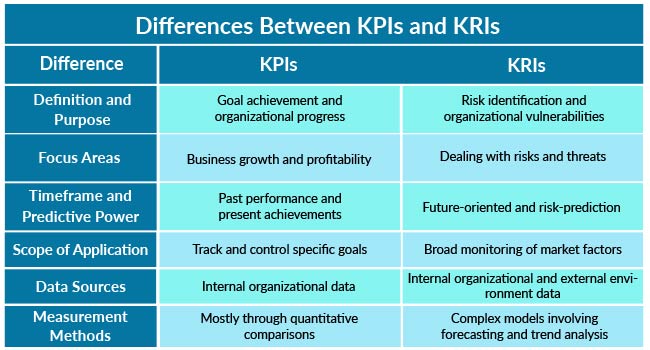
Definition and Purpose
The primary difference between KPIs and KRIs lies in their intent and role within the organization. KPIs are designed to measure how well a company is achieving its objectives. These indicators reflect progress in areas such as sales, productivity, customer satisfaction, and operational efficiency. They quantify performance and ensure that strategic goals are on track.
KRIs, on the other hand, are preventative by nature. Their purpose is to identify potential threats that could negatively impact performance or derail critical initiatives. KRIs do not measure operational success they measure vulnerability, offering early detection of risks that could compromise KPIs. For example, while a KPI might track quarterly revenue growth, a KRI would monitor increasing customer churn rates or declining market demand, highlighting risks that could hinder future revenue performance.
By defining success through KPIs and potential hazards through KRIs, businesses can align their growth strategies with risk management, ensuring that success is not achieved at the cost of hidden vulnerabilities.
Focus Areas
KPIs are primarily focused on outcomes that drive business growth and profitability. They spotlight performance areas such as revenue generation, employee productivity, market share, and customer retention. KPIs reflect the success of various business initiatives, showcasing the results of effective strategy execution.
KRIs operate in the background, targeting elements that threaten the achievement of business goals. KRIs deal with risk-prone areas such as compliance breaches, market instability, cybersecurity vulnerabilities, and operational inefficiencies. For instance, while a manufacturing KPI may track the percentage of products delivered on time, a corresponding KRI would monitor supply chain disruptions or chance of equipment failures that could delay production.
By differentiating focus areas, businesses can maintain a proactive stance focusing on improving performance while simultaneously addressing underlying risks. This dual focus is particularly vital for mid-sized organizations, where resource constraints amplify the impact of operational disruptions.
Timeframe and Predictive Power
A significant difference between KPIs and KRIs is in their timeframes. KPIs are predominantly retrospective or present-focused, measuring current and past performance to assess how well the organization is progressing toward its objectives. For example, a KPI might indicate how much market share was gained over the last quarter.
KRIs, in comparison, focus on the future, offering predictive insights into potential risks that may materialize. They serve as early warning signals, allowing businesses to anticipate and mitigate threats before they escalate. A rise in employee absenteeism, for instance, could serve as a KRI predicting workforce shortages or declining productivity in the near future.
This predictive quality makes KRIs indispensable for long-term strategic planning, as they provide foresight that KPIs cannot. By incorporating KRIs alongside KPIs, businesses gain a 360-degree view of their operations celebrating past and present successes while safeguarding the future.
Scope of Application
KPIs are typically used to measure the direct results of business activities. These indicators are outcome-driven, tracking specific goals such as revenue targets, customer acquisition rates, or marketing campaign performance. They highlight how well an organization is executing its strategies.
In contrast, KRIs focus on the factors that influence or jeopardize those outcomes. For instance, a financial KPI might track quarterly profit margins, while a KRI would monitor economic downturn indicators, which could signal potential profit declines in the future. KRIs broaden the scope of risk management, ensuring that businesses account for external and internal factors that may not be immediately visible but have the potential to impact performance.
This broader focus ensures that while KPIs drive action toward success, KRIs safeguard those efforts by addressing the root causes that might impede progress. By integrating these two frameworks, organizations ensure they are not only tracking success but also keeping watch over barriers to achieving it.
Data Sources
The data sources for KPIs and KRIs differ significantly. KPIs are tracked primarily from internal data sources sales records, financial statements, employee performance reports, and operational data. These data points are concrete and quantifiable, offering clear insights into how the organization is performing.
KRIs generally draw from a blend of internal and external data sources. In addition to internal data, KRIs might leverage industry reports, market trend analyses, regulatory changes, and global risk assessments. For example, a banking institution’s KRIs might include geopolitical factors or economic forecasts that could influence market stability. This expanded data pool ensures that KRIs account for broader risk landscapes that internal KPIs might overlook.
By utilizing diverse data sources, KRIs provide a richer, more holistic view of potential risks, enabling businesses to remain agile in the face of external uncertainties.
Measurement Methods
The methods used to calculate KPIs and KRIs are another area of divergence. KPIs are typically measured through straightforward, quantitative methods. These might include calculating and comparing growth rates, ratios, percentages, or other well-established performance metrics.
KRIs, on the other hand, require more sophisticated techniques, including risk modeling, scenario analysis, and trend forecasting. Since KRIs deal with predictive insights, they frequently involve assessing probabilities and estimating the potential impacts of events rather than providing definitive figures. For instance, a cybersecurity KRI might involve analyzing patterns of attempted breaches over time to forecast the likelihood of a future attack.
The difference in measurement techniques underscores the complementary relationship between KPIs and KRIs. While KPIs tell businesses where they stand, KRIs offer insight into where they might be headed, necessitating a balanced approach to strategic growth and risk management.
How KPIs and KRIs Work Together
While there are differences between KPIs and KRIs, there are also several points of convergence. As KPIs drive business performance by tracking progress toward goals, KRIs provide the foresight needed to anticipate and mitigate potential risks that could undermine those efforts. Together, they form a cohesive system that measures and protects success.
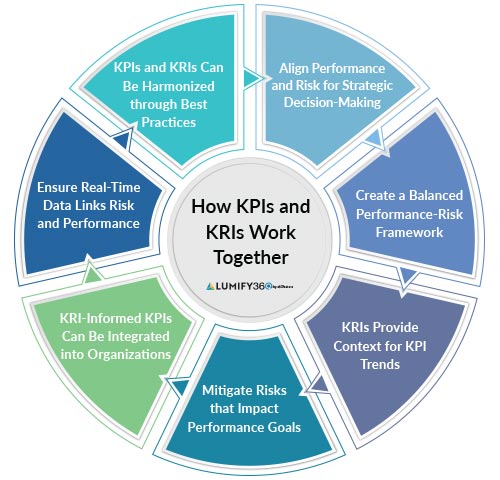
Aligning Performance and Risk for Strategic Decision-Making
KPIs and KRIs act as two sides of the same coin one drives ambition, while the other ensures caution. In a mid-sized business, leadership must consistently make strategic decisions that push growth while safeguarding the organization from unforeseen pitfalls. KPIs offer a clear snapshot of how well the company is performing against set targets, but without KRIs, this view can be incomplete and overly optimistic. KRIs provide an essential counterbalance by identifying red flags when pursuing a strategy at an early stage.
Consider the banking sector. KPIs, such as the number of new loan accounts opened, may indicate growth, but KRIs, like the ratio of non-performing loans, provide insight into the quality and risk level of that growth. Without factoring in the risk metrics, aggressive expansion may expose the business to financial instability. By aligning both performance and risk, decision-makers can achieve growth without compromising resilience.
Creating a Balanced Performance-Risk Framework
A well-rounded KRI-informed KPI framework does not prioritize performance over risk or vice versa; instead, it integrates the two seamlessly. Mid-sized organizations often operate in competitive markets where rapid growth is essential, but so is the need to manage external disruptions. By building a performance-risk framework, businesses can strike a balance between innovation and stability.
Take the manufacturing industry, for instance. A manufacturing company tracking production volume (a KPI) will also need to monitor supplier reliability (a KRI). Even if production targets are being met, an increasing trend in supplier delays could signal potential disruptions down the road. By tracking both indicators in a single view, the company can mitigate potential supply chain issues before they affect production output. This approach enables organizations to balance operational goals with risk awareness, minimizing the risk of costly disruptions.
Using KRIs to Provide Context for KPI Trends
The achievement of KPIs often varies from one period to the next, and it is critical to understand the real reasons behind such fluctuations. When a business notices declining customer acquisition (a KPI), it might seem like a marketing or sales issue. However, tracking related KRIs, such as negative feedback or product defects, could point to the underlying cause of such a decline.
By continuously monitoring KRIs alongside KPIs, businesses gain deeper insights into cause-and-effect relationships. For example, a healthcare provider tracking patient satisfaction KPI scores could interpret declining trends more accurately if paired with KRIs like appointment wait times or staff turnover. This contextual view enables faster, more accurate decision-making, preventing performance dips from escalating.
Mitigating Risks that Impact Key Performance Goals
KRIs are invaluable because they highlight emerging risks and provide the opportunity for proactive mitigation. Without KRIs, businesses may find themselves reacting to crises rather than anticipating and preventing them. Organizations can develop mitigation strategies that protect critical KPIs by identifying risks early.
Consider a mid-sized insurance firm that monitors the KPI of policy renewal rates. If the firm tracks KRIs, such as rising claim rejection rates or an increase in regulatory penalties, it can predict potential dissatisfaction among policyholders. Addressing these issues through process improvements or customer engagement initiatives can safeguard renewal rates and prevent losses. Proactive risk mitigation preserves performance achievements, ensuring that short-term wins contribute to long-term growth.
Integrating KPIs and KRIs into Organizations
The integration of KPIs and KRIs fosters a more comprehensive, organization-wide approach to strategic planning. Various departments within a business will track their own KPIs, but aligning them with the shared organizational KRIs encourages collaboration and a unified risk-aware culture. This holistic approach enhances transparency and drives collective ownership of both performance and risk management.
Consider some examples of such integration:
- In banking, KPIs like loan origination rates can be paired with KRIs such as economic downturn indicators.
- In manufacturing, production efficiency KPIs can be balanced by KRIs monitoring machine downtime or supply chain vulnerabilities.
- In healthcare, patient retention KPIs can be supported by KRIs tracking regulatory compliance breaches.
By embedding KRIs into operational workflows, businesses ensure that risk awareness becomes part of day-to-day decision-making rather than a separate process.
Leveraging Real-Time Data to Link Risk and Performance Metrics
Modern businesses are increasingly relying on real-time data to remain agile in today’s fast-paced environments. Platforms like Lumify360 allow mid-sized organizations to track KPIs and KRIs simultaneously, providing up-to-the-minute insights that drive informed decisions. Real-time data facilitates faster responses to emerging risks and ensures that performance metrics are always interpreted with the latest risk information in mind.
For example, a logistics company that has built its competitive edge on quick delivery times (a KPI) may need to track real-time traffic data (a KRI) to predict potential delays. In the same vein, a retail business tracking inventory turnover (a KPI) can use live data on supplier disruptions (a KRI) to prevent stockouts.
Real-time insights transform risk and performance management into a dynamic, responsive process that aligns with the pace of modern business.
Best Practices for Harmonizing KPIs and KRIs
To fully realize the benefits of KPI and KRI integration, mid-sized businesses should adopt the following best practices:
- Align Indicators with Strategic Goals – Ensure that KPIs and KRIs directly tie to the organization’s broader strategic objectives. This prevents the tracking of irrelevant metrics and ensures that insights are actionable.
- Regular Reviews and Updates – Risk environments evolve, so KRIs must be reviewed periodically to reflect new threats and emerging challenges. This ensures that KRIs remain relevant and effective.
- Cross-Department Collaboration – Engage teams across departments in KPI and KRI development. Involving multiple perspectives helps create a more balanced and comprehensive performance-risk framework.
- Leverage Technology – Use platforms like Lumify360 that unify KPI and KRI tracking in real-time dashboards. Automating data collection and analysis enhances accuracy and responsiveness.
- Foster Transparency and Accountability – Share KPI and KRI insights across the organization. Clear communication ensures that teams understand how performance and risk metrics influence their objectives and day-to-day operations.
- Focus on Leading Indicators – When selecting KRIs, prioritize leading indicators that provide early warnings, allowing teams to mitigate risks before they impact KPIs.
By embedding these practices, businesses can create a dynamic framework that enhances both performance and resilience.
Challenges in Balancing KPIs and KRIs
While integrating KPIs and KRIs ensures strategic success, mid-sized businesses often encounter several challenges in maintaining the right balance between performance and risk management. Addressing these obstacles is critical to ensuring that neither growth ambitions nor risk mitigation efforts are compromised.
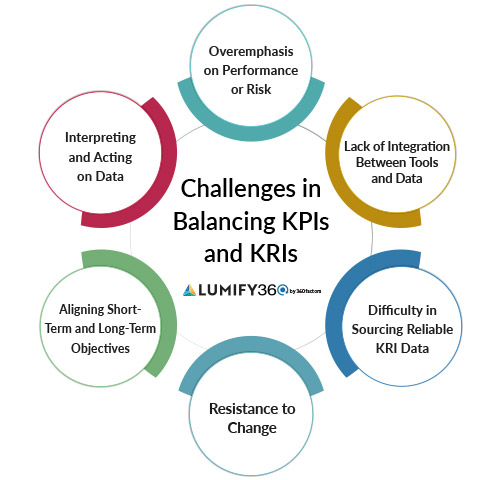
Overemphasis on Performance or Risk
Organizations sometimes lean too heavily on either KPIs or KRIs, creating an imbalance. In organizations where KPIs dominate, there is a risk of setting aggressive goals without adequate safeguards, which could lead to unforeseen risks. Conversely, organizations that focus excessively on KRIs can become overly cautious, stifling growth and innovation. Achieving the right equilibrium requires leadership to foster a culture where performance and risk are viewed as complementary forces rather than competing priorities.
Lack of Integration Between Tools and Data
Many businesses track KPIs and KRIs using separate platforms or spreadsheets, resulting in fragmented insights. Without integration, it becomes difficult to correlate performance metrics with risk indicators, reducing the effectiveness of decision-making. A siloed approach can lead to missed signals or delayed responses to emerging threats. A unified system that consolidates both sets of indicators into a single dashboard is essential for real-time, holistic analysis.
Difficulty in Sourcing Reliable KRI Data
Unlike KPIs, which are often based on internal performance data, KRIs generally rely on external data sources—such as market trends, regulatory changes, or economic conditions. Accessing and interpreting this data can be challenging, particularly for mid-sized businesses with limited resources. Additionally, identifying the right KRIs that accurately reflect potential risks requires thorough analysis and ongoing evaluation. Leveraging AI-driven tools and predictive analytics can streamline data collection and enhance the accuracy of KRI insights.
Resistance to Change
Implementing a dual focus on performance and risk is likely to face internal resistance, particularly from teams accustomed to prioritizing only KPIs. Employees may perceive KRIs as barriers to achieving aggressive performance targets. Overcoming this resistance requires leadership to clearly communicate the value of KRIs in sustaining long-term performance and fostering resilience. Providing training and involving teams in the development of KRIs can help drive adoption and alignment across the organization.
Aligning Short-Term and Long-Term Objectives
KPIs are often designed to track short-term performance, while KRIs typically focus on long-term risk exposure. Balancing these conflicting time horizons can create tension within strategic planning. Businesses must develop frameworks that accommodate both, ensuring that immediate performance gains do not jeopardize future stability. This requires forward-looking leadership that prioritizes sustainable growth alongside quarterly results.
Interpreting and Acting on Data
Even when KPIs and KRIs are successfully integrated, interpreting the relationship between them can be complex. A decline in a KPI may not always correspond to a risk identified by a KRI, leading to confusion about the appropriate course of action. Mid-sized businesses should invest in analytical capabilities or platforms that provide contextual insights, enabling leaders to make informed decisions based on the interplay between performance and risk metrics.
Importance of Integrating Both KPIs and KRIs
The integration of KPIs and KRIs is essential for sustainable growth and creating a comprehensive organizational culture that supports strategic advancement. Here are some key benefits of integrating KPIs and KRIs into business strategy.
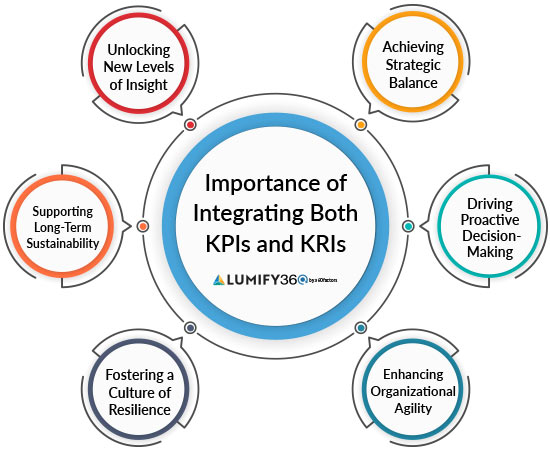
Achieving Strategic Balance
KPIs provide visibility into how well a business is achieving its objectives, while KRIs identify potential threats that could derail these efforts. When integrated, KPIs and KRIs offer a balanced perspective that ensures performance improvements are not achieved at the expense of increased exposure to risk.
Driving Proactive Decision-Making
By leveraging KRIs alongside KPIs, businesses can adopt a proactive rather than reactive approach to risk management. This foresight allows leadership to address potential issues before they escalate, ensuring that strategic goals are met without interruption.
For example, an increasing KRI related to employee turnover could signal risks to productivity, prompting adjustments to workforce strategies before KPI targets, such as production output, are negatively affected.
Enhancing Organizational Agility
Businesses that integrate KPIs and KRIs are better equipped to adapt and pivot. Real-time insights into both performance and risk enable organizations to respond quickly to emerging threats or capitalize on new opportunities.
Fostering a Culture of Resilience
Integrating KPIs and KRIs also cultivates a risk-aware culture across the organization. When teams understand the interconnectedness of performance and risk, they are more likely to factor risk considerations into their daily decision-making.
Supporting Long-Term Sustainability
Overreliance on performance indicators alone can lead to short-term wins but long-term instability. Conversely, an overemphasis on risk can hinder growth and innovation. The integration of KPIs and KRIs strikes a balance, allowing businesses to pursue new initiatives confidently while safeguarding future stability.
Unlocking New Levels of Insight
Modern data analytics platforms, such as Lumify360, empower businesses to integrate KPIs and KRIs seamlessly, providing real-time dashboards and predictive analytics. This technological support transforms raw data into actionable insights, enhancing the accuracy and relevance of both performance and risk metrics.
Businesses that adopt such solutions gain a competitive edge by making data-driven decisions that account for the full spectrum of opportunities and threats.
How Technology Helps Integrate KRIs and KPIs
KPIs and KRIs require data-intensive reviews. Managing these metrics manually or through disconnected systems can lead to inefficiencies and missed insights. Technology is playing a transformative role in bridging this gap, enabling seamless integration and delivering real-time, actionable intelligence.
Major avenues where technology supports the integration of KPIs and KRIs include the following:
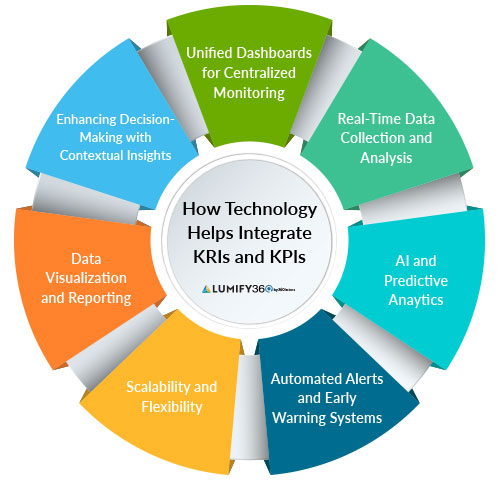
Unified Dashboards for Centralized Monitoring
Advanced performance and risk management platforms, like Lumify360, combine KPIs and KRIs into unified dashboards. This consolidation provides leadership with a holistic view of organizational health, allowing them to track performance and assess risk simultaneously. By visualizing both metrics side by side, businesses can correlate trends and identify patterns that might go unnoticed in isolated systems.
Real-Time Data Collection and Analysis
Modern platforms facilitate the automatic collection and analysis of data from multiple sources—internal systems, external market data, and third-party reports. This ensures that KPIs and KRIs are consistently updated, reflecting the most current business conditions.
AI and Predictive Analytics
AI and predictive analytics enhance the precision of KPI and KRI integration by identifying hidden correlations and forecasting future risks. For instance, predictive models can analyze new regulations, financial performance, and market fluctuations to anticipate potential disruptions to business operations. This proactive approach allows businesses to mitigate threats and sustain performance momentum.
Automated Alerts and Early Warning Systems
Technology enables businesses to set automated thresholds for KRIs, triggering alerts when risk levels approach critical limits. These early warning systems allow teams to take corrective actions promptly, ensuring that performance objectives remain on track. This automation reduces the burden on staff, allowing them to focus on strategic initiatives rather than constant risk monitoring.
Scalability and Flexibility
For mid-sized businesses, scalable technology solutions ensure that KPI and KRI integration grows alongside the organization. Whether expanding into new markets or launching new product lines, integrated systems can adapt to evolving metrics and risks without extensive reconfiguration. This flexibility is essential for businesses operating in dynamic industries like banking, healthcare, and manufacturing.
Data Visualization and Reporting
Advanced visualization and reporting tools translate complex KPI and KRI data into intuitive charts and graphs, simplifying analysis and communication across departments. Stakeholders at all levels can easily interpret performance and risk insights, fostering collaboration and aligning teams around shared goals. Additionally, automated reporting features streamline the process of generating compliance and performance reports, saving time and ensuring accuracy.
Enhancing Decision-Making with Contextual Insights
Last but not least, integrating KPIs and KRIs through technology provides a better context for decision-making. When performance metrics dip, risk indicators can shed light on underlying causes, helping leadership implement targeted solutions. This comprehensive understanding ensures that strategic decisions are data-driven and account for both performance potential and risk exposure.
Conclusion
Balancing both performance and risk is essential for mid-sized businesses striving to achieve long-term success. Key performance indicators drive growth, while key risk indicators safeguard that growth by identifying potential threats. When integrated, these two types of metrics create a powerful framework that empowers organizations to make informed, strategic decisions that foster resilience and sustainable expansion.
Technology in KPI and KRI Implementation
Technology is playing a pivotal role in integrating KPIs and KRIs into businesses, transforming them from static reports into dynamic, actionable insights. Solutions like Lumify360 support SMEs in consolidating performance and risk data into a single platform. This enables real-time monitoring and predictive analytics that allow businesses to stay ahead of potential risks.
Automated alerts, AI-driven forecasts, and intuitive dashboards ensure that relevant stakeholders can proactively address vulnerabilities while driving performance. By adopting technology that aligns with organizational needs, mid-sized businesses can enhance decision-making, improve operational efficiency, and create a balanced performance-risk ecosystem.
Take the Next Step
Explore how Lumify360 can transform your approach to KPIs and KRIs, providing seamless integration and valuable insights tailored to your organization’s goals. The platform is designed to simplify the process of managing risk and performance, ensuring you always have the information you need to make timely and informed decisions.
Take the first step toward a smarter, data-driven approach to managing risks and achieving growth performance.
- Explore Lumify360: Discover how our platform can meet your unique business needs.
- Request a Demo: See Lumify360 in action and learn how it enhances KPI and KRI management.
